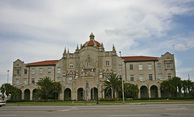 Click image to enlarge. (Courtesy Wikimedia)
Click image to enlarge. (Courtesy Wikimedia) The three-story terminal sits on 3.5 acres and encompasses more than 63,000 square feet. A set of original building plans is housed at the University of South Alabama Archives.
|
 Click image to enlarge. (Courtesy Wikimedia) Click image to enlarge. (Courtesy Wikimedia) Constructed in 1905 during the heyday of U.S. rail transportation, particularly passenger transportation, the GM&O terminal is typical of the grandiose railroad buildings erected across the country during the early twentieth century. Significant architecturally as a fine example of the Spanish Colonial Revival style, the building also has historical significance for the role it played in the history of transportation. From 1905 through 1958, this building was the major rail terminus for North/South and East/West passengers across the Gulf Coast region. Designed by P. Thornton Marye of Atlanta, the building was listed on the National Register of Historic Places in 1976. The structure served as the terminal for the combined Mobile and Ohio Railroad and the Southern Railroad until 1940 when the M&O merged with the Gulf, Mobile and Northern to form the Gulf, Mobile and Ohio. Later the company was acquired by Illinois Central. Passenger service was discontinued in 1958, after which the building served as offices for the railroad. Vacated in 1986, the building has changed hands several times and is now for sale.
The three-story terminal sits on 3.5 acres and encompasses more than 63,000 square feet. A set of original building plans is housed at the University of South Alabama Archives.
0 Comments
Leave a Reply. |
Alabama's Endangered Historic LandmarksEach year since 1994, Alabama Heritage has highlighted threatened historic sites throughout Alabama. The “Places in Peril” list has identified more than 215 imperiled historic resources throughout the state, and is compiled by the Alabama Historical Commission and the Alabama Trust for Historic Preservation. The locations highlight the results of deferred maintenance, perceived obsolescence, development pressures, and lack of funding—forces that now more than ever threaten our cultural legacy. But awareness is a powerful force, too, and can cultivate a renewed determination to be responsible stewards of our heritage. For more information, visit the AHC or the ATHP websites. Alabama Heritage is proud to bring to you a selection of the places designated as perilous. Please keep your comments to information relevant to the featured place in peril. Alabama Heritage reserves the right to delete any comment that we deem inappropriate. Archives
May 2024
|
|
Alabama Heritage
Box 870342 Tuscaloosa, AL 35487 Local (205) 348-7467 Toll-Free (877) 925-2323 [email protected] |